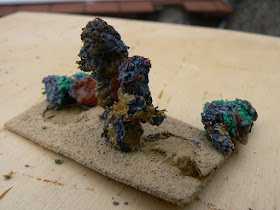Casualty figures, but not as we know them.
Some figures unable to be restored.
Half a dozen figures from a very old collection (several decades) probably about 1000 figures strong which will have to be binned.
I can't blame the environment in which the boxes have been kept while in my possession (several years) as I have extensive collections from several decades old to brand new, painted and unpainted, soft plastic, hard plastic, resin, lead and pewter.
I don't recall them showing signs of this when I first took care of them so they must be a recent development. Maybe that is how lead rot works.
Any ideas chaps?



I've had precious few figures get lead rot, and all of them have been from a single manufacturer that I'm fairly sure was using waste lead as his primary lead source. Possibly due to not being fluxed well or with some incompatible metals in the alloy?
ReplyDeleteI have no way of identifying these figures without a lot of hassle which I'm not keen to have. They are casualties, c'est la vie.
DeleteJim,
ReplyDeleteI’ve never seen lead rot that looked like that. It looks as if someone has tried to strip them with something like Nitromors paint stripper. Have they been in contact with anything containing acid?
All the best,
Bob
Not to my knowledge Bob, They were in a box along with about 100 other figures which are all fine.
DeleteOh ! , never seen it that bad ! , I must admit I've only come across 'lead rot' twice in 50 years of gaming .
ReplyDeleteMe neither.
DeleteLead Rot is caused by dampness:
ReplyDeletehttps://boardgamegeek.com/wiki/page/Lead_Rot
The figures have been in a heated, damp free environment for a few years and the file boxes they were in look as if they are brand new.
DeleteI suspect that the lead alloy itself is suspect.
They look as if they would work in some sort of wierd Scince Fiction scenario!
ReplyDeletePerhaps not. They create a lot of grey dust which might transfer their re-action to other figures.
DeleteTerrible! I've encountered that phenomenon only once, and I suspected contaminated material caused it. You're right, the only recourse is to bin them.
ReplyDeleteI binned them this afternoon.
DeleteNow I have to inspect another 6 file boxes (several hundred figures) for any further rot.
Just found some of the grey dust in the bottom of two of the boxes. Will have a closer look tomorrow.
DeleteThey have a bit of an unsettling look about them! Hopefully the rest will be fine.
ReplyDeleteJust been through the rest of the boxes. Found about another dozen or so figures which are affected including a couple of cavalry.
DeleteThere are a couple which I will attempt to rescue as they are relatively unique in the collection. The other will get binned.
I've read about this on several occasions.
ReplyDeleteThe best Science I could find was from a museum with lead cast ships in wood and glass display cabinets.
Their conclusion was that some sort of gas released from wood, or the wood-glass seal set a reaction running.
They were fairly keen on acetic acid as the culprit, and I've winced ever since when bloggers talk about washing their figures in vinegar to etch the surface as a key for paint.
The other scare, which affects me, is the emissions form curing silicone sealant.
I use this to hold steel sheet in place in storage boxes.
Probably a risk for plastic boxes like the really useful types where any gas would be sealed in.
The big take-away form all the chemistry in that paper was to identify and isolate (or bin) the affected models as quick as possible.
The lead breakdown is a multi-step process which excretes more of the bad stuff as it goes.
So you've a self sustaining attack on your figures.
I believe the fix was to take them all out for a good airing, and identify and bin any with a sign of rot.
Museums with massive budgets have a broader range of options: glass and stainless steel cabinets, active ventilation or a pure nitrogen environment.
Sorry for the vagueness, it's been a long time.
The worst ones were unceremoniously binned. I did keep half a dozen infantry and a couple of horse riders as I needed them to make up unit numbers.
DeleteI stripped the paint from them, scrapped away any suspicious rot, varnished them, filled any unsightly gaps, replaced any broken weapons, painted and varnished them. It may take a few years for them to deteriorate again and I don't expect to have them in my possession by then. They may survive.
Useful "lead rot" link here, with a bit of the chemistry, but not enough to damage my brain. http://www.blmablog.com/2018/11/revisiting-lead-rot.html
ReplyDeleteThanks for that.
Delete